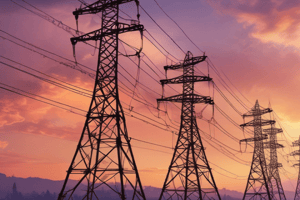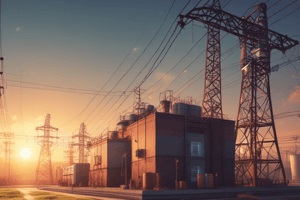Podcast
Questions and Answers
What is the primary purpose of power transmission?
What is the primary purpose of power transmission?
To transmit power over long distances with minimal loss of energy.
What is the typical voltage range used in power transmission?
What is the typical voltage range used in power transmission?
115 kV to 765 kV
What is the main difference between power transmission and electric power distribution?
What is the main difference between power transmission and electric power distribution?
Voltage and distance; transmission is high-voltage over long distances, while distribution is lower-voltage over shorter distances.
What are the two main types of transmission lines?
What are the two main types of transmission lines?
What is the primary function of insulators in transmission lines?
What is the primary function of insulators in transmission lines?
What is the purpose of grounding systems in transmission lines?
What is the purpose of grounding systems in transmission lines?
What is the typical voltage range used in electric power distribution?
What is the typical voltage range used in electric power distribution?
What is the main purpose of transformers in electric power distribution?
What is the main purpose of transformers in electric power distribution?
Flashcards are hidden until you start studying
Study Notes
Power Transmission
- Definition: The bulk transfer of electrical energy from generating power plants to substations near populated areas.
- Purpose: To transmit power over long distances with minimal loss of energy.
- Characteristics:
- High voltage (typically 115 kV to 765 kV)
- Low current
- Efficient transmission over long distances
- Components:
- Transmission towers
- Overhead transmission lines
- Underground transmission cables
- Substations (transformers, switches, and circuit breakers)
Electric Power Distribution
- Definition: The delivery of electrical energy from substations to consumers.
- Purpose: To provide reliable and efficient power supply to individual customers.
- Characteristics:
- Lower voltage (typically 3 kV to 35 kV)
- Higher current
- Distribution over shorter distances
- Components:
- Distribution substations
- Overhead distribution lines
- Underground distribution cables
- Transformers (step-down)
- Distribution panels and meters
Transmission Lines
- Definition: The conductors used to transmit electrical energy over long distances.
- Types:
- Overhead transmission lines (aerial lines)
- Underground transmission cables
- Components:
- Conductors (aluminum or copper wires)
- Insulators (support and isolate conductors)
- Towers or poles (support conductors)
- Grounding systems (protect against lightning and faults)
- Characteristics:
- High voltage and low current
- Designed to minimize energy losses and electromagnetic interference
- Often built with redundancy and backup systems for reliability
Power Transmission
- Bulk energy transfer: From generating power plants to substations near populated areas.
- Minimal energy loss:Transmission over long distances with minimal loss of energy.
- High voltage: Typically 115 kV to 765 kV.
- Low current: Efficient transmission over long distances.
- Transmission infrastructure: Towers, overhead transmission lines, underground transmission cables, and substations (transformers, switches, and circuit breakers).
Electric Power Distribution
- Energy delivery: From substations to consumers.
- Reliable power supply: Efficient and reliable power supply to individual customers.
- Lower voltage: Typically 3 kV to 35 kV.
- Higher current: Distribution over shorter distances.
- Distribution infrastructure: Distribution substations, overhead distribution lines, underground distribution cables, transformers (step-down), distribution panels, and meters.
Transmission Lines
- Conductors: Aluminum or copper wires used to transmit electrical energy.
- Types: Overhead transmission lines (aerial lines) and underground transmission cables.
- Components: Conductors, insulators, towers or poles, and grounding systems.
- Design considerations: High voltage and low current, minimizing energy losses and electromagnetic interference.
- Redundancy: Built with redundancy and backup systems for reliability.
Studying That Suits You
Use AI to generate personalized quizzes and flashcards to suit your learning preferences.




